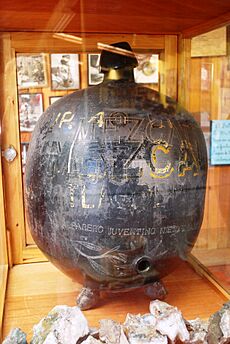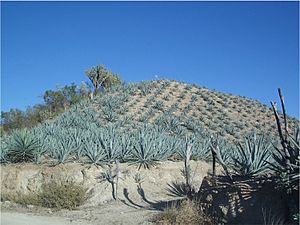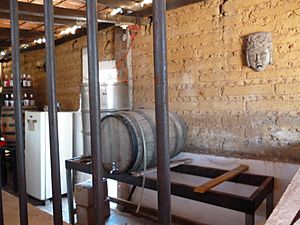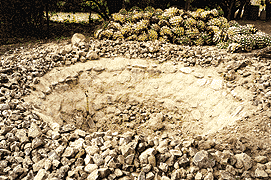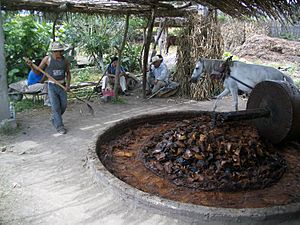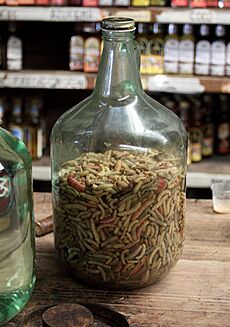Mezcal facts for kids
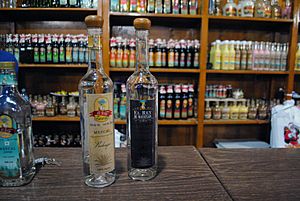
Bottles at a factory in Teotitlán del Valle, Oaxaca
|
|
| Type | Distilled beverage |
|---|---|
| Country of origin | Mexico |
| Introduced | 16th century |
| Alcohol by volume | 40–55% |
| Proof (US) | 80–110° |
| Color | Clear or golden |
| Flavor | Sweet, fruity, earthy, smoky |
| Ingredients | agave |
| Related products | tequila, bacanora, raicilla, pulque |
Mezcal, sometimes spelled mescal, is a distilled alcoholic beverage made from any type of agave. The word mezcal comes from Nahuatl mexcalli which means "oven-cooked agave", from metl and ixcalli. Traditionally the word "mezcal" has been used generally in Mexico for all agave spirits and it continues to be used for many agave spirits whether these spirits have been legally certified as "mezcal" or not.
Agaves or magueys are endemic to the Americas and found globally as ornamental plants. More than 90% of mezcal is made in the Mexican state of Oaxaca, but is now produced and commercialized throughout Mexico for the national and international market. Native fermented drinks from maguey plant, such as pulque, existed before the arrival of the Spanish.
The origin of mezcal is tied to the introduction of distillation technology which was introduced to New Spain either by the Spanish or Filipino sailors.
In the 21st century, mezcal is still made from the heart of the agave plant, called the piña, in much the same way as it was 200 years ago. In Mexico, mezcal is generally consumed straight and has a strong smoky flavor. Though other types of mezcal are not as popular as tequila, Mexico does export the product, mostly to Japan and the United States, and exports are increasing as the liquor grows in popularity.
Contents
History
The agave was one of the most sacred plants in pre-Spanish Mexico, and had a privileged position in religious rituals, mythology and the economy. Cooking of the "piña", or heart, of the agave and fermenting its juice was practiced. The origin of this drink has a myth. It is said that a lightning bolt struck an agave plant, cooking and opening it, releasing its juice. For this reason, the liquid is called the "elixir of the gods".
While fermented drinks from agave (like pulque) is pre-colonial, the distillation of agave heart juice into mezcal was only introduced in the colonial era. How stills reached New Spain remains a point of scholarly dispute; some historians attribute the propagation of distillation to the Spanish who learned the process during the Moorish rule of Iberia, while others trace its origins to Filipino sailors who, after the opening of the galleon trade in the 1570s, brought stills with them to make vino de coco (coconut liquor).
By the early 1600s, the Spanish colonial government and the Real Audiencia in Spain banned vino de coco and issued an order for the destruction of coconut plantations in Colima because it competed with the sales of imported spirits from Spain. Although this wasn't complied with completely, the prohibition of vino de coco led to the expansion and commercialization of the production of mezcal to fill the local demand for cheap liquor. The first mention of distilled agave spirits in colonial records is from 1619, by the Spanish cleric Domingo Lázaro de Arregui. He mentions that the indigenous peoples in the coastal regions of the Sierra de Nayarit were distilling "mexcales". By 1638, the governor of Nueva Galicia also started to regulate the sale of mezcal. Mezcal became banned shortly after. By 1643, there are records of mezcal and vino de coco being sold in Guadalajara.
The production of mezcal moved from the coastal river basins of the Río Grande de Santiago to the inland ravines by the early 1700s to evade the prohibition on spirits production, as well as to take advantage of the larger numbers of wild agave plants in the interiors. The plants used expanded to highland cultivars of Agave angustifolia, as well as Agave rhodacantha in Jalisco, and Agave hookeri in Michoacán.
By the mid-1700s, the production of vino de coco had ceased completely due to the prohibition and the loss of coconut plantations. But mezcal liquor survived because they were sourced from abundant wild agaves. The production sites moved to even more remote and difficult-to-access areas in the foothills of the Volcán de Colima, the ravines of the Colima Valley, and in the Chamila Valley. During this period, the first clandestine distilleries in the highlands of Jalisco were also established in the valleys of Amatitán, Tequila, Magdalena, and El Arenal; whose mezcal variant made specifically from blue agave later became the tequila.
The small size of the Philippine-type stills (consisting mostly of a tree trunk and two copper kettles) made it easy to disassemble and move while evading colonial authorities. The numerous well-like ancient graves cut into the rocks in the region were also coopted as fermentation basins for agave juice. The small size of the still also allowed distillers to produce agave liquor from a very small number of agave plants or even a single plant. These conditions led to the constant selection and vegetative propagation of wild agave plants with the best characteristics for agave liquor production, eventually resulting in the development of domesticated cultivars of agave.
In Colima, the fermented agave to be distilled into mezcal is still called tuba, the term adopted from the tubâ used to ferment vino de coco. The oldest agave spirits distilleries (called tabernas or viñatas) use Philippine-type stills, many of which are still operational. The technology was also transported through trade routes into Zacatecas, Guanajuato, Michoacán, Sonora, and the rest of Mexico, as well as parts of the southern United States, where modified Philippine-type stills have been reported.
Travelers during the colonial period of Mexico frequently mention mezcal, usually with an admonition as to its potency. Alexander von Humboldt mentions it in his Political Treatise on the Kingdom of New Spain (1803), noting that a very strong version of mezcal was being manufactured clandestinely in the districts of Valladolid (Morelia), State of Mexico, Durango and Nuevo León. He mistakenly observed that mezcal was obtained by distilling pulque, contributing to its myth and mystique. Spanish authorities, though, treated pulque and mezcal as separate products for regulatory purposes.
Mezcal agave
The agave plant is part of the Agavaceae family, which has almost 200 species. The mezcal agave has very large, thick leaves with points at the ends. When it is mature, it forms a "piña" or heart in the center from which juice is extracted to convert into mezcal. It takes between seven and fifteen years for the plant to mature, depending on the species and whether it is cultivated or wild. Agave fields are a common sight in the semi-desert areas of Oaxaca state and other parts of Mexico.
Varieties
Mezcal is made from over 30 agave species, varieties, and subvarieties, in contrast with tequila, which is made only with blue agave. Of many agave species that can be used to make mezcal, seven are particularly notable. There is no exhaustive list, as the regulations allow any agaves, provided that they are not used as the primary material in other governmental Denominations of Origin. The term silvestre "wild" is sometimes found, but simply means that the agaves are wild (foraged, not cultivated); it is not a separate variety.
Most commonly used is espadín "smallsword" (Agave angustifolia (Haw.), var. espadín), the predominant agave in Oaxaca. The next most important are arroqueño (Agave americana (L.) var. oaxacensis, sub-variety arroqueño), cirial (Agave karwinskii (Zucc.)), barril (Agave rodacantha (Zucc.) var. barril), mexicano (Agave macroacantha or Agave rhodacantha var. mexicano, also called dobadaan) and cincoañero (Agave canatala Roxb). The most famous wild agave is tobalá (Agave potatorum (Zucc.)). Others include madrecuixe, tepeztate, and jabalí. Various other varieties of Agave karwinskii are also used, such as bicuixe and madrecuixe.
Production
Traditionally, mezcal is handcrafted by small-scale producers. A village can contain dozens of production houses, called fábricas or palenques, each using methods that have been passed down from generation to generation, some using the same techniques practiced 200 years ago. This is an important difference with tequila which is nowadays mostly produced industrially.
The process begins by harvesting the plants, which can weigh 40 kg (88 pounds) each, and extracting the piña, or heart, by cutting off the plant's leaves and roots. The piñas are then cooked for about three days, often in pit ovens, which are earthen mounds over pits of hot rocks. This underground roasting gives mezcal its intense and distinctive smoky flavor. They are then crushed and mashed (traditionally by a stone wheel turned by a horse) and then left to ferment in large vats or barrels with water added.
The mash is allowed to ferment, the resulting liquid collected and distilled in either clay or copper pots which will further modify the flavor of the final product. The distilled product is then bottled and sold. Unaged mezcal is referred to as joven, or young. Some of the distilled product is left to age in barrels between one month and four years, but some can be aged for as long as 12 years. Mezcal can reach an alcohol content of 55%. Like tequila, mezcal is distilled twice.
Mezcal is highly varied, depending on the species of agave used, the fruits and herbs added during fermentation and the distillation process employed, creating subtypes with names such as de gusano, tobalá, pechuga, blanco, minero, cedrón, de alacrán, crema de café and more. A special recipe for a specific mezcal type known as de pechuga is distilled with a chicken breast. Other variations flavor the mash with cinnamon, pineapple slices, plátanos manzanos, and sugar, each imparting a particular character to the mezcal. Most mezcal, however, is left untouched, allowing the flavors of the agave used to come forward.
Not all bottles of mezcal contain a "worm" (actually the larva of a moth, Comadia redtenbacheri, that can infest agave plants), but if added, it is added during the bottling process. There are conflicting stories as to why such a thing would be added. Some state that it is a marketing ploy. Others state that it is there to prove that the mezcal is fit to drink, and still others state that the larva is there to impart flavor. Similar ingedients are scorpions (de alacrán) and snakes.
The two types of mezcal are those made of 100% agave and those mixed with other ingredients, with at least 60% agave. Both types have four categories. Joven (white) mezcal is clear and hardly aged. Dorado (golden) is not aged but caramel is added. This is more often done with a mixed mezcal. Reposado is aged in wood barrels from two to nine months. This can be done with 100% agave or mixed mezcals. Añejo is aged in barrels for a minimum of 12 months. The best of this type are generally aged from 18 months to three years. If the añejo is of 100% agave, it is usually aged for about four years.
Mexico has about 330,000 hectares (820,000 acres) cultivating agave for mezcal, owned by 9,000 producers. Over 6 million liters (1,300,000 imp gal; 1,600,000 U.S. gal) are produced in Mexico annually, with more than 150 brand names.
The industry generates about 29,000 jobs directly and indirectly. Certified production amounts to more than 2 million liters (440,000 imp gal; 530,000 U.S. gal); 434,000 liters (95,000 imp gal; 115,000 U.S. gal) are exported, generating 21 million dollars in income. To truly be called mezcal, the liquor must come from certain areas. States that have certified mezcal agave growing areas with production facilities are Durango, Guanajuato, Guerrero, Oaxaca, San Luis Potosí, Puebla, Michoacan, Tamaulipas, and Zacatecas. About 30 species of agave are certified for use in the production of mezcal. Oaxaca has 570 of the 625 mezcal production facilities in Mexico, but some in-demand mezcals come from Guerrero, as well. In Tamaulipas, 11 municipalities have received authorization to produce authentic mezcal with the hopes of competing for a piece of both the Mexican national and international markets. The agave used here is agave Americano, agave verde or maguey de la Sierra, which are native to the state.
Oaxaca produces 90% of the mezcal in Mexico, which presents a serious environmental threat to the state, according to local deputy Elena Cuevas Hernández. She notes that ten liters (2.2 imp gal; 2.6 U.S. gal) of water and seven kilograms (15 lb) of firewood are required for the production of one liter (0.22 imp gal; 0.26 U.S. gal) of mezcal, which comes to ten liters (2.2 imp gal; 2.6 U.S. gal) per batch consuming 6,000 liters (1,300 imp gal; 1,600 U.S. gal) of water and 2,100 kilograms (4,600 lb) of firewood. In 2019 Mexico produced 7.1 million liters (1,600,000 imp gal; 1,900,000 U.S. gal) of mezcal and consumed 1,429,000,000 liters (314,000,000 imp gal; 378,000,000 U.S. gal) of water and 45,000,000 kilograms (50,000 short tons) of wood. Water is used both for irrigation of the maguey plants and cooling the distilled product; wood is used to bake the leaves. Certain communities already control or prohibit cutting firewood. The deputy also warns of pollution related to inadequate disposal of rotting stalks left in the fields and pollutants with low pH (3 or 4) and methane (CH4). Yet another problem is the low pay that producers receive.
Festival
The state of Oaxaca sponsors the International Mezcal Festival every year in the capital city, Oaxaca de Juárez. There, locals and tourists can sample and buy a large variety of mezcals made in the state. Mezcals from other states, such as Guerrero, Guanajuato, and Zacatecas also participate. This festival was started in 1997 to accompany the yearly Guelaguetza festival. In 2009, the festival had over 50,000 visitors, and brought in 4 million pesos to the economy.
See also
 In Spanish: Mezcal para niños
In Spanish: Mezcal para niños
- Cocuy
- Kahlúa
- Mexican beer
- Mexican cuisine
- Mexican wine
- Miske
- Santiago Matatlán
- Sotol
- Tequila
- Tiswin


